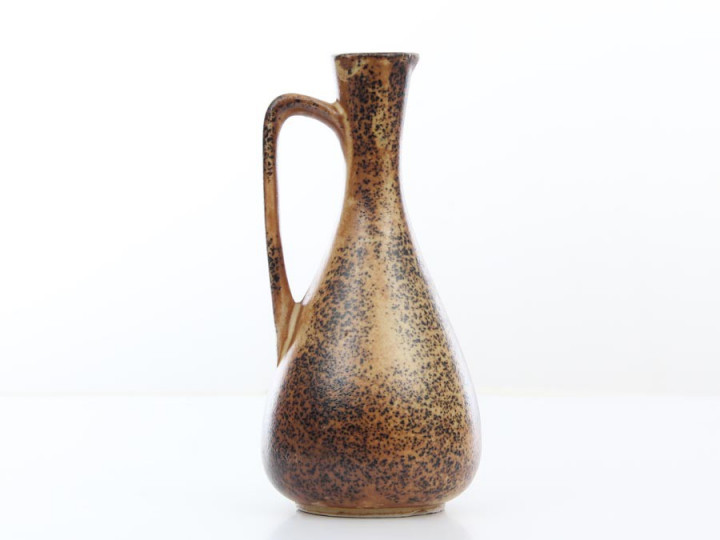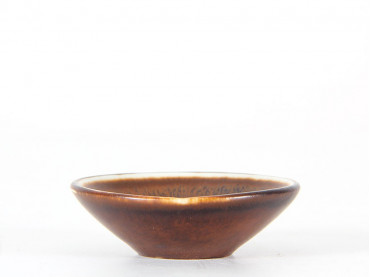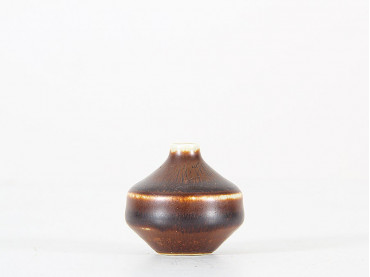Rorstrand Ever Glaze Firing vase. Test Piece by Carl Harry Stalhane
-
Carl Harry Stalhane
-
Rörstrand
- FC170203 Available
Rorstrand Ever Glaze Firing. Test Piece painted and laquered by Carl Harry Stalhane. Signed.
| Year | 1950's |
| Condition | Excellent vintage condition |
| Dimensions | H 14 cm |
| Material | Ceramic |
| Style | Classique Vintage |
| Origin | Sweden |
| Fournisseur | Rörstrand |
Carl Harry Stalhane
Swedish ceramic artist Carl-Harry Stålhane (1920- 1990) played a major role in popularizing Swedish pottery during the 20th century, working for more than three decades at Rörstrand, one of the oldest ceramics manufacturers in Europe. During his long tenure at Rörstrand, Stålhane was responsible for small-batch studio pieces, mass-produced tableware , and all manner of decorative accessories .
Born in 1920 in Mariestad, Sweden, Stålhane began working at Rörstrand in 1939 as a decorative painter, assisting Danish-Finnish ceramic artist, designer, and sculptor Gunnar Nylund (1904-1997). During this time, Stålhane decorated various ceramic pieces, most notably Nylund’s Flambé range (1939s), quickly establishing himself as a talented ceramic artist. Inspired by the desire for new products during the postwar economic boom, Stålhane went from being a talented decorator to an exceptional ceramic artist.
In 1943, Stålhane caught the eye of Swedish artist Isaac Grünewald (1889-1946), who was visiting Rörstrand. Grünewald was so impressed with Stålhane’s work that he took him on as a student, and from 1943 to 1946, Stålhane studied art at Grünewald's Art School in Stockholm. Subsequently from 1947 until 1948, he studied sculpture at Académie Colarossi in Paris.
During the 1950s, Stålhane’s work appeared in several solo exhibitions in Sweden, the United Kingdom, and the United States. His Blanca Tableware range (c. 1955) won numerous international prizes and was in high-demand. In 1958, Stålhane succeeded Nylund as Artistic Director and Chief Designer at Rörstrand.
In 1960, Stålhane unveiled a new collection at Stockholm’s Galerie Blanche. Featuring dark stoneware pieces made from local clays, this collection represented a bold departure from the soft, restrained shapes of the 1950s. It has since been praised for its precient aesthetic that would influence the look of ceramics for more than a decade.
From 1963 until 1971, Stålhane taught ceramics at the Art Industrial School in Gothenburg. For a short time, he also was the Design Director at the Swedish factory Upsala Ekeby, which in addition to porcelain, produced tile, brick, and glass.
Stålhane eventually left Rörstrand in 1973 in order to establish his own ceramic company, Designhuset, in Lidköping, where he further experimented with local clays and minerals. Stålhane continued to work until his death in 1990. Today, Designhuset is a school for ceramists and model-makers.
Over the course of his career, Stålhane created several public works for The Commerce Trust Company in Kansas City, Missouri, and for Volvo in Gothenburg, Sweden. His work is represented at several international museums, including Stockholm’s Nationalmuseum and New York’s MoMA.
source : pamono.fr










